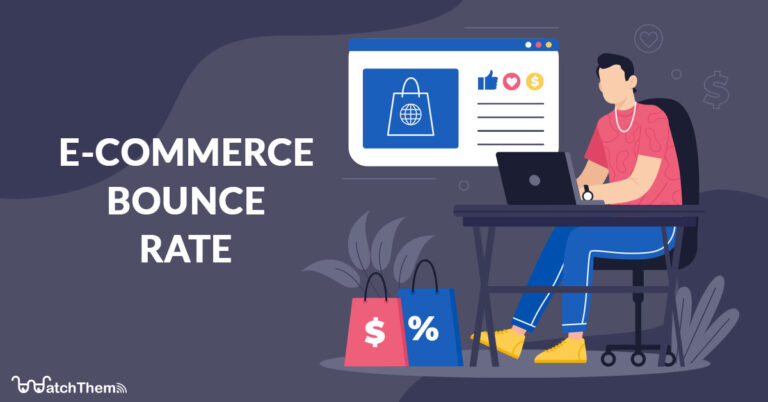Page Contents
If customers leave e-commerce stores without making a purchase, they will go bankrupt because of a high bounce rate. The primary purpose of an e-commerce store is to sell items online. A low e-commerce bounce rate may have nothing to do with your appealing website, brand name, etc. The question is that why are people leaving your website without shopping? What is a good bounce rate for e-commerce in 2022?
Here, we will discuss how to keep the e-commerce bounce rate low and conversion high. You will learn how to reduce the bounce rate and increase sales.
Note: WatchThemLive provides valuable tools to see every click of users on your website; therefore, you can reduce the bounce rate, fix your bugs and boost conversions. SIGN UP for FREE now!
What Is Bounce Rate on an E-commerce Website?
Bounce rate is a term that people get mixed up about because they think it refers to the visitors who came to your website and then left because they didn’t like it or it didn’t fulfill their search intent. But a bounce rate means a single-page session in which the user doesn’t take any action.
What Is a Session?
A session is the amount of time a visitor spends on your website. For example, it can be when visitors read your entire article, like in five or seven minutes, and then leave your site.
Exit Rate vs. Bounce Rate
Exit rate is the rate at which your visitors leave your website no matter how many pages they have viewed. On the other hand, bounce rate is the rate at which people bounce off your site without interacting.
Reasonable E-commerce Bounce Rate Benchmarks
According to the latest data, a reasonable e-commerce bounce rate is between 30% and 55%. But, in reality, a good bounce rate depends on the page people are landing on.
What Is Search Intent and How Does It Affect the Bounce Rate?
Search intent is the reason why a user searches a query. If visitors google “How to Pick the Best Birthday Gift for Girlfriend?” and they land on a product page that doesn’t fulfill the intent of their search, they will bounce.
If 99 out of 100 people do the same thing on that product page, even though your overall site has a 75 percent bounce rate, that particular page has a 99 percent bounce rate. If they land on your blog post titled “Which Gift Is Best for Girlfriend on Her Birthday?” then your post fulfills their search intent even if it has a 90 percent bounce rate. That’s because the users read it, and the post satisfies their search intent.
To reduce the bounce rate, you should encourage users to interact with your site. For example, you can ask them to subscribe to your gift shop mailing list. You can also add a pop-up that displays available options when they want to buy a gift, or perhaps a link to another blog post on appropriate gifts that lets them navigate through your site. These could potentially lower your bounce rate significantly.
How to Reduce Your E-commerce Bounce Rate
There is no quick solution to lowering your bounce rate; however, there are some tried-and-true methods that increase engagement:
1. Optimize Page Load Speed
This method is connected directly to your bounce rate; the visitors may abandon your page if your content doesn’t load in under three seconds. Your page speed can be decreased by optimizing your images, removing unused javascript, minifying markup and other codes, and using cache plugins.
2. Call the Users to Action with CTAs
One of the ways to reduce your bounce rate is by creating meaningful CTAs. Using the right colors and larger sizes can help you create more effective CTAs. Your CTAs shouldn’t be confusing; you want them to be noticeable. Using a constant banner at the top of the page or pop-ups can also help you reduce the bounce rate. Moreover, having an email subscription pop-up in the corner or a live chat widget increases user engagement.
3. Conduct A/B Tests
A/B testing consists of creating two versions of your page to distinguish which one is better and draws more attention. Therefore, you can choose a design with a lower bounce rate.
4. Create Better, More Fascinating Content
This doesn’t necessarily mean you have to improve your content quality. Sometimes all you need to do is to adjust your strategy to engage visitors with proper headlines, scannable images, and infographics.
Conclusion on E-commerce Bounce Rate
So what’s a good bounce rate? Do not worry about this because there is no benchmark and your bounce rate depends on many factors. There are many reasons behind different numbers that you hear.
The average bounce rate for e-commerce is something between 40 to 60 percent. Rather than looking for what a good bounce rate is, you should pay attention to other metrics like events and scroll depth and whether users’ interactions lead to conversions.
However, if your e-commerce bounce rate is really high, that may be a warning. So, you’d better analyze the pages with a high bounce rate and their traffic sources. For example, check if the page load speed is fast enough or if you are attracting the right visitors.
Using a behavior analytics tool such as WatchThemLive is an excellent way to find out why users bounce. This tool provides session replays that enable you to discover the reasons people leave your website.
Get instant access to WatchThemLive now!


